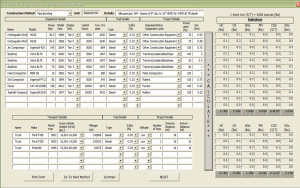April 2009 Vol. 64 No. 4
Features
First Look: Software Compares Carbon Footprint Of Trenchless, Open-Cut Construction Methods

Vermeer Corp. has introduced a software tool for estimating the environmental impact of various underground utility construction methods.
E-Calc compares construction methods and calculates the emissions that could be expected from that specific method of construction.
“E-Calc can provide information that allows project owners, planning engineers and contractors to evaluate available construction methods and determine which option may cause the least harm to the atmosphere,” said Ed Savage, Vermeer’s trenchless segment manager. “As regulatory pressure grows to reduce harmful emissions, E-Calc may be a helpful tool for protecting owners in documenting emissions records for carbon credits.”
The tool can calculate estimated emissions that can be expected from four methods of construction: horizontal directional drilling, pipebursting, open cut with excavators or backhoes, and open cut by trenching.
E-Calc software is available as a free download from the Vermeer web site, www.vermeer.com, or a CD may be ordered from Vermeer. The program is written in Microsoft Excel 2003.

Savage said E-Calc is simple to use.
To estimate emissions generated by different construction methods, project information is entered, followed by input from one to two methods of construction. Default settings for underground equipment are Vermeer models. For other equipment brands, the user manually enters specifications for engines and usage hours.
Development
E-Calc was developed for Vermeer by Dr. Samuel T. Ariaratnam, professor at the Del E. Webb School of Construction, Arizona State University.
“The E-Calc tool’s estimates are based strictly on construction equipment and doesn’t include emissions based on traffic patterns,” said Ariaratnam. “And it also takes into account more than carbon – that’s just part of it. It looks at six different pollutants: carbon dioxide (CO2), carbon monoxide (CO), nitrogen oxide (NOx), total organic compounds (TOC), sulfur oxide (SOx) and smoke and particulate matter (PM 10) , all identified by the United States Environmental Protection Agency (EPA) as being emitted from equipment engines.”
The E-Calc summary shows graphs and emissions values for the six factors.
Ariaratnam said engineers planning projects today are faced with identifying the construction option that not only provides the best cost advantage, but also considers environmental sensitivities.
Trenchless methods offer enhanced environmental benefits compared to traditional open cut construction methods due to the reduced amount of onsite equipment generally required and faster completion schedules.
Concluded Savage: “Quantifying the estimated emissions from various underground construction options reveals environmental considerations that are vital in sustaining our environment. And E Calc is a practical way to develop information to help planners select the best method of construction.”
FOR MORE INFORMATION:
Vermeer Corp., (888) 837-6337, www.vermeer.com




Comments